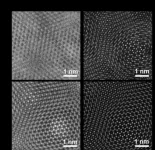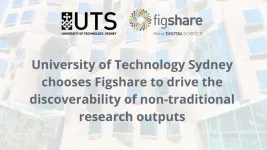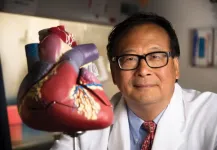(Press-News.org) Researchers at the University of Illinois at Urbana-Champaign have shown for the first time that expensive aberration-corrected microscopes are no longer required to achieve record-breaking microscopic resolution.
The field of microscopy is in the middle of a great revolution. Since the 1800s and the invention of the compound light microscope, there have only been a few major jumps in resolution to see different length scales: from bacteria and cells, to viruses and proteins, and even down to single atoms. Generally, as resolution has been making these incredible jumps, so has the price of the microscopes used to achieve that resolution. Such hefty price tags severely limits the accessibility of these instruments. The current jump in resolution comes from a new technique called electron ptychography—a method that uses computation to boost the resolution of electron microscopes—which has taken the field by storm in the last 5-6 years.
Researchers at the University of Illinois Urbana-Champaign have demonstrated record-breaking resolution using electron ptychography on “conventional” transmission electron microscopes (conventional meaning without expensive aberration correctors). This breaks the trend of increasing microscope price with increasing resolution. They were able to achieve deep sub-angstrom spatial resolution down to 0.44 angstrom (one angstrom is one ten-billionth of a meter), which exceeds the resolution of aberration-corrected tools and rivals their highest ptychographic resolutions.
“For the last 90-100 years, our field has thought that the way to do great microscopy is to make better and better microscopes,” says materials science & engineering professor Pinshane Huang, who led this work. “The most exciting thing about our research is that we’re showing that you don’t need a cutting-edge microscope to make this work. We can take a ‘conventional’ microscope and do the same thing, using ptychography, and it’s just as good! This is amazing because there can be a multi-million-dollar difference in cost between the two setups.”
This research, co-first authored by former MatSE UIUC postdoctoral researcher Kayla Nguyen, former MatSE UIUC graduate student Chia-Hao Lee and Argonne National Laboratory staff scientist Yi Jiang, was recently published in the journal Science.
Before ptychography, the highest resolution electron microscopes used a technology called aberration-correction to allow scientists to see individual atoms. Rather than using a beam of light to probe a sample, electron microscopes use a beam of electrons, focused by electromagnets. Electrons have wavelengths thousands of times smaller than visible light, which allows electron microscopes to resolve objects that are many times smaller than can be seen with optical microscopes. Scientists use these microscopes to decode the structures of objects ranging from the spike protein on the COVID-19 virus to the arrangements of atoms in graphene and, more generally, to peer inside matter to understand its atomic
structure, composition and bonding.
However, one of the challenges of using beams of electrons is focusing that beam. “It’s impossible to make a perfect lens for electrons,” Huang says. “What people have been doing to compensate is making ‘bad’ lenses, and then putting aberration correctors after them, which are a series of ‘bad’ lenses that are ‘bad’ in opposite ways. Summed together, they make ‘okay’ lenses, and that’s been the gold standard for how we image at the atomic scale for at least 20 years.”
In optics, an aberration is any way that a lens deviates from a perfect lens. For example, human eyes can have several types of aberrations such as short- and near-sightedness (eyes can’t focus at all distances) and astigmatism (curvature of the eyeball that causes blurred vision). Lee explains, “For electromagnetic lenses, the way to focus these electrons is through an electromagnetic field. But we don’t have a great way of controlling the shape and the strength of the electromagnetic field, which puts a very strong limitation on how precise we can be focusing these electrons.” In aberration-corrected microscopy, the current cutting-edge technology, there is an extra stack of lenses to correct the aberrations from the regular lenses, that changes the shape of the beam before it hits the sample. Those extra aberration correcting lenses are where significant costs are added to the microscope.
While it is impossible to make a perfect lens, the goal of the last 100 years has been to continuously make better lenses to minimize aberrations. But Huang says, “What’s exciting about ptychography is that you don’t have to make better and better lenses. What we can do instead is use computers.”
Rather than using a stack of lens optics to remove aberrations, ptychography removes them computationally. With a new generation of detectors, called hybrid pixel detectors, that cost a few hundred thousand dollars (compared to aberration-corrected microscopes that cost up to $7 million) and computer algorithms, this method can double, triple or even quadruple the resolution of what a microscope can achieve with its physical lenses. Huang and her team have shown that their approach quadruples the resolution of conventional transmission electron microscopes. Further, nearly any scanning transmission electron microscope can now be adapted to achieve state-of-the-art resolution at a fraction of the cost.
While this approach is game-changing, Huang notes that ptychography is still a challenging technique that requires a lot of computation power. It can take hours to get a single reconstruction to reach the best resolution. But, as with many other technologies, computation advances quite rapidly and gets cheaper, faster and easier to use.
“We brought a cutting-edge technique, electron ptychography, to conventional transmission electron microscopes to show for the first time that a ‘mediocre’ microscope can do just as well as the most expensive microscopes on the market,” Huang says. “This is significant for the hundreds of institutions across the country and across the world who previously couldn’t afford the cutting edge. Now, all they need is a detector, some computers and electron ptychography. And once you do that, you can see the atomic world with much more detail than anyone imagined even 10 years ago. This represents a huge paradigm shift.”
*
Pinshane Huang is also the Associate Director of the Materials Research Laboratory at UIUC.
Kayla Nguyen is currently an assistant professor at the University of Oregon and Chia-Hao Lee is currently a post-doctoral researcher at Cornell University.
Other contributors to this work include Priti Kharel (department of chemistry, UIUC), Yue Zhang (department of mechanical science and engineering, UIUC) and Arend M. van der Zande (department of materials science and engineering, department of mechanical science and engineering, Materials Research Laboratory, UIUC).
This research was funded primarily by the Air Force Office of Scientific Research, with additional support from the U.S. Department of Energy, the National Science Foundation, and the L’Oreal For Women in Science Postdoctoral Fellowship.
END
Reimagining electron microscopy: Bringing high-end resolution to lower-cost microscopes
2024-02-26
ELSE PRESS RELEASES FROM THIS DATE:
ACP recommends ways to better meet the health care and social needs of unhoused populations
2024-02-26
@Annalsofim
Below please find summaries of new articles that will be published in the next issue of Annals of Internal Medicine. The summaries are not intended to substitute for the full articles as a source of information. This information is under strict embargo and by taking it into possession, media representatives are committing to the terms of the embargo not only on their own behalf, but also on behalf of the organization they represent.
----------------------------
1. ACP Recommends Ways to Better Meet the Health Care ...
University of Technology Sydney chooses Figshare to drive the discoverability of non-traditional research outputs
2024-02-26
Figshare, a leading provider of institutional repository infrastructure that supports open research, is pleased to announce that the University of Technology Sydney (UTS) has chosen Figshare to support them in sharing, showcasing and managing their research reports and non-traditional research outputs.
UTS – Australia’s leading technology university – will use its Figshare repository and its integration with the Australian Research Data Commons Datacite DOI minting service to drive the discoverability and increase the impact of their research reports and non-traditional research outputs, ...
Five grand challenges for the future at the interface of engineering and medicine
2024-02-26
BIRMINGHAM, Ala. – Just imagine this, the creation of:
An artificially intelligent machine that acts as a human exocortex, a system that will interface with and make an old brain tick normally.
Human cells that can sense metastatic cancer or the boundaries of solid tumors and respond with killing of tumor cells, release of inflammatory payloads or bioluminescence to help guide surgical removal.
Manufactured vaccines that prevent or impede a cancer, block opioid action or reverse autoimmune diseases like multiple sclerosis.
These are a few of the far-reaching ideas put forward by 50 international biomedical engineering ...
Australian researcher's journey from kangaroo whisperer to global dance sensation
2024-02-26
Dr Weliton Menário Costa, a PhD graduate from The Australian National University (ANU), has been announced the overall winner of the 2024 global Dance Your PhD contest after wowing judges with his wickedly creative and quirky dance submission, ‘Kangaroo Time (Club Edit)’.
One of the world's leading researchers in kangaroo behaviour, he is the first person from ANU to win the Dance Your PhD competition, and just the fourth person from an Australian institution to do so since its inception in 2008.
Better known as ‘WELI’, the singer-songwriter, creator and biologist weaves together a funky beat, original songwriting, drag queens and Brazilian funk dancers ...
Black carbon sensor could fill massive monitoring gaps
2024-02-26
Black carbon is the most dangerous air pollutant you’ve never heard of. Its two main sources, diesel exhaust and wood smoke from wildfires and household heating, produce ultrafine air particles that are up to 25 times more of a health hazard per unit compared to other types of particulate matter. Despite its danger, black carbon is understudied due to a lack of monitoring equipment. Regulatory-standard sensors are wildly expensive to deploy and maintain, resulting in sparse coverage in regions infamous for poor air quality, such as the greater Salt Lake City metropolitan area in Utah.
A University of Utah-led study found that the AethLabs ...
UC Irvine advances stem cell research with $4 million CIRM grant for shared resources lab
2024-02-26
Irvine, Calif., Feb. 26, 2024 — The University of California, Irvine has received a five-year, $4 million grant from the California Institute for Regenerative Medicine to establish a shared resources lab in the Sue & Bill Gross Stem Cell Research Center. The facility will offer essential technologies and training for the development of novel in vitro stem cell-based modeling that will serve researchers across the campus and the state.
“Stem cells possess the potential to transform into particular cell types, offering promising avenues for rejuvenating and restoring tissues harmed by injury or affected ...
New discovery suggests significant glacial retreat in West Antarctica began in 1940s
2024-02-26
Among the vast expanse of Antarctica lies the Thwaites Glacier, the world’s widest glacier measuring about 80 miles on the western edge of the continent. Despite its size, the massive landform is losing about 50 billion tons of ice more than it is receiving in snowfall, which places it in a precarious position in respect to its stability.
Accelerating ice loss has been observed since the 1970s, but it is unclear when this significant melting initiated – until now. A new study published in the journal PNAS, led by researchers ...
Butterflies mimic each other’s flight behaviour to avoid predators
2024-02-26
Researchers have shown that inedible species of butterfly that mimic each others’ colour patterns have also evolved similar flight behaviours to warn predators and avoid being eaten.
It is well known that many inedible species of butterfly have evolved near identical colour patterns, which act as warning signals to predators so the butterflies avoid being eaten.
Researchers have now shown that these butterflies have not only evolved similar colour patterns, but that they have also evolved similar ...
What math tells us about social dilemmas
2024-02-26
Human coexistence depends on cooperation. Individuals have different motivations and reasons to collaborate, resulting in social dilemmas, such as the well-known prisoner's dilemma. Scientists from the Chatterjee group at the Institute of Science and Technology Austria (ISTA) now present a new mathematical principle that helps to understand the cooperation of individuals with different characteristics. The results, published in PNAS, can be applied to economics or behavioral studies.
A group of neighbors shares a driveway. Following a heavy snowstorm, the entire driveway is covered in snow, requiring clearance for daily activities. ...
Protecting fish doesn’t have to mean neglecting people, study concludes
2024-02-26
BEAUFORT, N.C. –With fish stocks declining globally, more than 190 countries recently made a commitment to protect about a third of the world’s oceans within “Marine Protected Areas,” or MPAs by the year 2030. But these designated areas of the ocean where fishing is either regulated or outright banned can come at a huge cost to some coastal communities, according to a new analysis.
To help prepare for the expansion of MPAs, an international team of researchers from Duke University, Florida State ...







